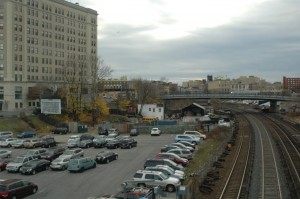A vision for Mount Vernon

From his restaurant and pizza shop on Gramatan Avenue, Frank Capuano has had a good, long view of the changes in retail businesses and their changing customers in downtown Mount Vernon.
“I”™ve been here 37 years,” he said behind the counter at Pizza King, a short walk from City Hall and Mount Vernon Hospital.
“I”™ve seen it come and go. You see a decline.”
On this November day, another small-business entrepreneur had gone. Augustine Lee, a former practicing architect, opened Cafeteria 57, a coffee shop on Gramatan Avenue, in September 2010. His take-out customers, downtown retail workers, found it closed this morning.

“Everybody”™s closing,” said a manager of Gramatan Avenue restaurant and deli properties that include the Cafeteria 57 store. “We”™ve got to work with the city.”
“It”™s unfortunate that people who run the city, they don”™t run a business,” said Capuano. “They don”™t know how to administrate.”
The restaurant owner blames high taxes and inadequate public services, including the quality of local schools, for the city”™s decline.
“The taxes are too high and senior citizens don”™t stay,” he said.
“As soon as they retire, they move. They cannot afford to stay.”
Capuano said many firefighters, police officers and civil-service workers also have moved outside Mount Vernon. “These are the people you”™ve got to keep in your community. These are what keep the community balance.
“Mount Vernon used to be all factories. They got chased away ”“ taxes, taxes, taxes.”
The city”™s downtown needs more professional offices, in the restaurant owner”™s view. “There are too many restaurants and not enough businesses to sustain them,” he said.
“The city needs a mixture of business and residential.”
A push for increasing diversity
That street-level view of Mount Vernon”™s development needs is largely shared by HR&A Advisors Inc., the New York City consulting firm that recently completed a market and development study for the city.
Among the “first moves” to spur long-term development, the consultants said Mount Vernon should focus on increasing the diversity of its residential and commercial environments and increasing retail activity.
The study found promising opportunities for transit-oriented development at both the Mount Vernon West and Mount Vernon East stations of Metro-North Railroad. Consultants recommended the city change zoning to allow for mixed-use development in those areas with an emphasis on multi-family residential construction.
The train-station areas include 570,000 square feet of space for potential industrial and commercial development on land owned by the city or Westchester County.
Consultants said the city “should seek to bridge its traditional manufacturing base and nascent creative industries.” Its industrial buildings near the Mount Vernon West station could be converted to live-work space for artists, as the city of Peekskill has done successfully, and for use by industrial arts enterprises.
The study also recommended the city establish a kitchen incubator in industrial space to support startup catering, retail and wholesale food businesses.
”˜South Westchester”™s Main Street”™
HR&A analysts estimated that 40 percent of retail spending by Mount Vernon residents and workers, about $205 million, occurs outside the city. Capturing one-half of that potential spending would support 365,000 square feet of additional retail space in the city.
In a downtown survey of 250 storefronts, consultants found 27 percent were vacant. Those vacancies can deter new business investment in a downtown that needs to attract more regional and national retailers, they said.
The consultants suggested restaurants could anchor a revitalized downtown and become a focal point of cluster promotion efforts to attract Westchester consumers. The village of Port Chester, the self-proclaimed “restaurant capital of Westchester County,” has been successful with that approach.
“Gramatan Avenue can become south Westchester”™s Main Street, an authentic place of diverse businesses and vibrant street life serving area residents, downtown employees and restaurants,” the consultants said in their report.
At Pizza King, Capuano was more skeptical.
“A restaurant district, it”™s not going to work,” he said. “The fast foods, they”™ll survive. But the upscale, unless they bring in the offices too and the hotels, it”™s not going to survive. It”™s pretty hard for big restaurants to come in.”
The city”™s consultants agreed in part with the restaurant owner”™s assessment. The city”™s lack of hotels and catering facilities “is a constraint on attracting visitors,” they said in the study.
MOUNT VERNON TO-DO LIST
The city consultant”™s key recommendations include:
- Hire an economic development director;
- Create a downtown business improvement district;
- Rezone to allow mixed-use development; and
- Create a kitchen incubator.
TICKET TO THRIVE
The downtown area around the Mount Vernon East train station is opportune for developers:
- 84 sites with some 5,000 square feet of land and less than 50 percent developed;
- 7.9 million square feet of developable commercial residential and manufacturing space;
- 200,000 square feet on city-owned land; and
- 330,000 square feet on county-owned land.